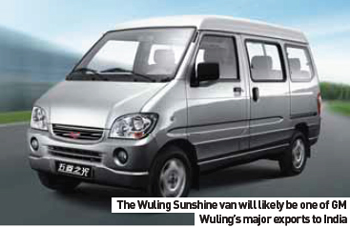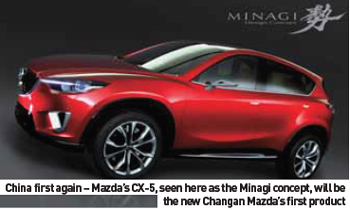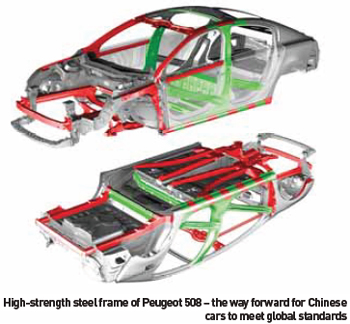As China’s vehicle market continues to grow, carmakers from around the world are racing to keep up with demand while local OEMs plan to start regional exports
While it is difficult to get an exact number of carmakers and assemblers currently operating in China, the recent Auto Shanghai 2011 event showcased 1,110 vehicles presented by 2,000 automotive-related companies (including joint venture partners) from 20 different countries or regions.
Domestic brands were prominent, with the ‘Big Six’ domestic and JV manufacturers: FAW, SAIC, Dongfeng, Changan, GAC and BAIC showing concepts, new and existing models, alongside smaller players such as Brilliance, Geely, Great Wall, Lifan, Haima, BYD and Jonway.
In addition to the raft of vehicles with traditional powertrains, new-energy vehicles were given a prominent position at the event, with hybrids and pure electrics powered by batteries using a range of substances that included traditional lithium to hydrogen gas. With competition in the so-called ‘green car market’ growing ever more fierce, every major exhibition stand dedicated a portion of its display area to new-energy vehicles – which, unlike preceding years, were not displayed as concepts but as models ready to enter production.
A first-time visitor to the show could have been forgiven for thinking that China was the global leader in new-model design and development, such was the number of models on display, many of which were destined for export or for production in Chinese-owned plants in regions outside the country. In fact, while the local market continues to grow apace, many Chinese OEMs are building, or planning to build, their first (or more) plants in markets outside their home territory.
In late March 2011, Lifan Industry Group and the Effa Group (a Brazilian importer of Chinese brands) said they will invest $70 million in Brazil to build Lifan’s first automotive research and development centre outside China.
Located between the cities of São Paulo and Campinas in São Paulo state, the centre will develop a range of products, including alternative-energy motors and a compact model for global markets. The facility will also help to certify vehicles sold in Latin America. In 2010, Lifan and Effa had combined sales of just over 5,000 vehicles - although the companies have no plans as yet to build a full assembly plant in Brazil, some of their vehicles are currently produced in Uruguay, making such an investment possibly part of a longterm vision.
In addition to activities in Brazil, March this year saw Lifan begin Russian production of its 320 compact model, the latest car to enter in-country production. With the 320 joining production of the 520 and 620 models, capacity in Russia is likely to jump from 14,000 to 32,000 units per annum.
Chery – cheap, and available now
Chinese automotive group Chery Automobile recently launched its QQ model in Brazil. Priced at almost R$23,000 ($14,600), the QQ is marketed as the cheapest car available in the country, a title previously held by the Fiat Uno Mille Economy (R$23,220). The QQ will compete with the Chevrolet Celta (R$26,115) and the Chinese-built Effa M100, offered at a starting price slightly under R$25,000.
First presented at the São Paulo Auto Salon last October, the QQ is aimed at the new Brazilian middle class, which is estimated to number 90 million people, according to the chairman of Chery in Brazil, Luís Curi, who has targeted a 2011 sales total of 12,000 units of the QQ. In 2010, Chery Brasil sold 7,800 units, made up of various models, while the total sales goal for this year will be 25,000 units. Curi added that to support this, the existing network of resellers would be increased from 75 to 100 outlets. The increased sales will be supported by Chery Automobile’s new, R$400 million production plant. Located in Jacareí, near São Paulo, it will be the group’s first plant outside China.
General Motors – export and fly
 GM is planning to export the Chinese-designed and manufactured Chevrolet Sail to India over the next few months, making it one of the first Chinese cars to be imported into India.
GM is planning to export the Chinese-designed and manufactured Chevrolet Sail to India over the next few months, making it one of the first Chinese cars to be imported into India.
President and Managing Director of the General Motors China Group, Kevin E. Wale, revealed his intention to sell in the Indian automobile market, saying that the joint venture would use so-called ‘low-priced vehicles’ to enter the market, adding that any specific details would have to come through GM’s joint ventures in India. The new Sail and recentlyreleased Shanghai GM Wuling Baojun are speculated to be among the models to be marketed in India.
General Motors India, established at the end of 2009, currently operates factories in Halol, Gujarat and Talegaon, Maharastra, which have a combined production capacity of 225,000 vehicles and 160,000 engines. GM India will reportedly release three commercial and two passenger vehicles (including the Chevrolet Spark, a rebadged Daewoo Matiz) in the country next year.
 In late 2009, Shanghai GM set up a company in India with two factories, located in Halol and Talegaon, with a combined production capacity of 225,000 vehicles and 160,000 engines. By 2012, Shanghai GM is expecting to have five models available in the Indian market, three of which will be light commercials, likely based on Wuling vans, plus the already-confirmed Chevrolet Spark. Wuling, which also controls the Baojun brand, has stated that it will look to advance the latter brand before looking to expand into other markets. Wuling vans are under going testing in India, with local CKD production slated to start in the medium term.
In late 2009, Shanghai GM set up a company in India with two factories, located in Halol and Talegaon, with a combined production capacity of 225,000 vehicles and 160,000 engines. By 2012, Shanghai GM is expecting to have five models available in the Indian market, three of which will be light commercials, likely based on Wuling vans, plus the already-confirmed Chevrolet Spark. Wuling, which also controls the Baojun brand, has stated that it will look to advance the latter brand before looking to expand into other markets. Wuling vans are under going testing in India, with local CKD production slated to start in the medium term.
At the Shanghai 2011 Motor Show, Ford officially announced that it will introduce 15 new models into China by 2015: “Under the direction of the ‘One Ford’ strategy, Ford will standardize its global product lineup within the next four years,” said president of the company’s Asian division, Marin Burela. “These new models will strengthen our competitive position, as well as allow Ford to enter segments they don’t have a presence in yet.”
Currently Ford has started R&D covering ten models scheduled to be released under the plan. The thirdgeneration Focus will be the first of the 15 models Joseph Hinrichs promised to bring to China, with the new car scheduled to arrive in 2012. The Focus will also be the first model made at the new Changan Ford Mazda production facility; built at a cost of RMB490 million ($75m), the plant will have a 150,000upa capacity.
Details surrounding the split of Changan Ford Mazda, confirmed by Xu Liuping, Chairman of Changan Automobile, at the Shanghai motor show, would see both transplants inherit a 50% share of the existing company. While the move is still awaiting final approval from China’s National Development and Reform Commission, Mazda has already stated that it would relocate to Nanjing to undertake development of its first model as an independent JV, the Mazda CX-5 SUV.
Chongqing Changan Automobile, the same carmaker involved with both Ford and Mazda in China, and the manufacturer behind the Chana brand, recently revealed that it was exploring the possibility of launching its own range of cars. Speaking with AMS in Shanghai, general manager of Changan Auto, Zhang Baolin, offered an overview of what the project could involve. “There will be new models and probably a new brand, but we will continue to work with our partners.” More Chinese automakers look likely to follow the same route, as plans are put in place to produce own-brand models after decades of joint-venture production with transplant carmakers.
This would mark a major deviation in the market. For example, Changan currently produces the Focus, Fiesta and Mondeo in China, while also retailing the Mazda2 and Mazda3.
 A recent drive in the new Peugeot 508 saloon and estate models brought the global nature of Chinese production into sharp focus; how the balance has shifted as more cars are designed with China as the target market. With models such as the 508, the Chinese market has the purchasing power to eclipse the combined sales of all other world markets.
A recent drive in the new Peugeot 508 saloon and estate models brought the global nature of Chinese production into sharp focus; how the balance has shifted as more cars are designed with China as the target market. With models such as the 508, the Chinese market has the purchasing power to eclipse the combined sales of all other world markets.
Peugeot is planning to reinforce its presence in China by launching at least one new model per year, starting with the new saloon. According to the French carmaker, local production of the 508 – operated in partnership with Donfeng, in Wuhan - will represent 50% of the car’s total manufacturing run. With an anticipated local sales volume of 65,000 units in the first year, the range will make up a considerable portion of PSA’s plan to achieve total sales of 200,000 units in China this year.
The 508 replaces the 407and the larger Peugeot 607, which will have no direct replacement. The platform and most engine options are shared with the second-generation Citroen C5: the two cars are produced together at the company plant in Rennes, France (AMS September/October will feature coverage of 508 production at Rennes). It is reported that Peugeot expects China to be the largest market for the car, delivering nearly twice as many cars there as in the carmaker’s home market – a first for a model also available in the French market.
Along with the 508 saloon, Peugeot also held the world premiere of a new SUV concept vehicle at the Shanghai Auto Show, the study having been designed and developed by the China Technical Centre, located in Shanghai. If it was at all necessary, this preview serves to underline the importance of the Chinese market to PSA.
Electric dreams – new-energy vehicles
Dürr is building an additional paintshop for Chery Automobile, at its facility in Wuhu. Upon completion of this €60 million project, Chery will command a total paint capacity of 1.1 million vehicles per year. Dürr is developing and installing the entire paintshop for Chery, including application technology. While interior paint is applied manually, exterior painting is completed automatically using EcoRP 6 robots with EcoBell2 atomizers. A new element is the use of water-based paints in the primer and top coat areas, which make the painting process much more environmentally friendly. The plant will begin operations in December 2012, and will serve to expand capacity at the Wuhu location. It is designed for a three-shift operation with an annual capacity of 335,000 vehicles.
At a conference in Beijing, Philip Murtaugh, CEO of electric vehicle manufacturer Coda Automotive, recently announced that the company’s Chinese-produced EVs will make an official North American debut at the end of this year.
The California-based manufacturer produced the vehicle with co-operation from battery developer Tianjin Lishen and Changan Automobile Group’s Hafei brand. Officials at Coda’s Chinese arm claim that the car has a 200km range after a six-hour charge. According to sources within Lifan, which is involved with similar together with American company Miles Automotive Group, the car will be offered for about $45,000, not including government compensation of up to $7,500. The company plans to export 1,000 vehicles a year.
Other OEMs with well-advanced electric and hybrid vehicle programmes include SAIC, which in 2010 rolled out a medium-hybrid version of its Roewe 750 saloon, claimed to reduce running costs by 20%. A plug-in hybrid Roewe 550 saloon is planned for 2012, while a range of fuel cell vehicles are expected to be trialed over the next two years, before production starts in 2015.
Chongqing Changan, the nation’s fourth-largest carmaker, plans to invest RMB1.2 billion ($186 million) over the next two years developing new-energy vehicles, with a focus on pure EVs. This is no idle dream – the company will have developed and launched eight new-energy models by the end of 2010, including the BenBen Love and Mini electric cars, Zhixiang HEV hybrid, Jiexun HEV mild hybrid and a fuel cell SUV, also called Zhixiang.
The company is aiming to have 200,000 energy-efficient and new-energy vehicles on the road by 2015, together with an output of ‘core spare parts’ – batteries and controllers – of 500,000 sets by the same date. South Korean battery manufacturer LG Chem will jointly develop lithium-ion batteries for the new-energy vehicles.
Build your dreams – Chinese style
 While BYD is viewed as the premier electric/hybrid vehicle maker in China, actual figures are not so impressive. Although the company boasts that more than two million kilometres have been covered by its E6 electric taxis in 2010, BYD sold just over 1,000 of its F3DM plug-in hybrid in 2010. The carmaker has since said that its total new-energy vehicle sales will top 10,000 units in 2011.
While BYD is viewed as the premier electric/hybrid vehicle maker in China, actual figures are not so impressive. Although the company boasts that more than two million kilometres have been covered by its E6 electric taxis in 2010, BYD sold just over 1,000 of its F3DM plug-in hybrid in 2010. The carmaker has since said that its total new-energy vehicle sales will top 10,000 units in 2011.
An interesting move was BYD’s RMB600 million jointventure with Daimler. Started in 2010, the partnership is scheduled to produce an all-electric car by 2013, while BYD has also partnered Volkswagen in researching possible production of electric traction batteries.
Other local players in the Chinese EV and hybrid market include Geely, which received production permits for two EV models, codenamed EK-1 and EK-2, which have yet to enter production. FAW is also investigating new-energy potential; the company currently has three EVs under development, all based on its Besturn platform. By the end of 2012, FAW plans to have a production capacity of 50,000 new-energy vehicles, manufactured at its first new-energy vehicle production base in Changchun.




























